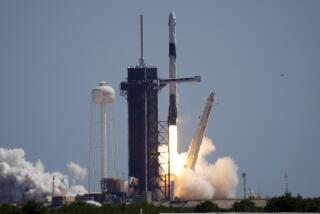At Moscow Air Show, Hopes Soar for Sales of Technology : Aviation: The breadth of items on display is striking. The Russians seem prepared to market everything from satellites to cruise missiles.
- Share via
MOSCOW — Four years ago, Leonid Pichugov was a mechanic tightening bolts on aircraft undercarriages at a local Soviet airport. On Tuesday, he was standing in a suit next to a mock-up of the eight-passenger plane that his company, Interavia, is hoping to peddle worldwide out of a rented former MIG fighter-plane factory near here.
Many such transformations, and hopes for more, went on display Tuesday as Russia’s most ambitious air show ever opened at two airports and a vast exhibition hall on the banks of the Moscow River.
Although Moscow hosted air shows in 1990 and 1992, this year’s organizers denigrate those as mere exhibitions; this one, they say, is the largest ever in Russia and the first one really devoted to selling local goods, technology and know-how.
The breadth of items on display was striking. Russian plants--including state-owned, private and privatized enterprises--seem prepared to market everything from satellites to cruise missiles, airliners and space capsules. The Russian military is participating in the show for the first time, promoting itself as a partner in training and technical exchanges.
“Eighteen months or two years ago this would never have been allowed,” Air Commodore Philip J. Wilkinson, the defense attache of the British Embassy in Moscow, said as he took a first stroll through the corridors. “It would have been unthinkable to have had this kind of technology out on display.”
The state-owned Sukhoi Design Bureau is even showing a very preliminary mock-up of a supersonic transport, notwithstanding the sorry history of the Concorde and the problematic technical, political and economic future of a proposed Western second-generation SST.
The scale of the show reflects Russian aerospace’s self-image as potentially one of the country’s most competitive industrial sectors; organizers here hope to turn the show into a biannual affair starting in 1995. They say 500 exhibitors, including 200 foreign firms, signed up for display space. The organizers say they expect daily attendance to go as high as 30,000 a day for the seven-day show, an expectation that could not be assessed fully on the show’s first day. A good chunk of that total might be confined to the more popular flight shows at a local airport where admission, characteristically, is $20 for foreigners, $2.50 for locals.
Visitors to the main venue could also get a hint of some of the domestic industry’s inadequacies, chief of which is unfamiliarity with the demands of international trade. “Our future is promising because we have very talented, educated workers,” said Yuri Chernikov, a representative of a technical institute offering its services in “standards and compliance.” “We just don’t have enough experience.”
That is a big demerit, given the unprecedentedly tight global market for big aircraft and the bloodthirsty nature of competition among established Western companies. “The problem today is finding the customers,” Wilkinson said.
Pichugov and many other small businessmen had their feelers out for potential foreign collaborators, not only to fill in marketing shortcomings but also to send money. Pichugov’s company is represented at the Moscow show chiefly because it’s inexpensive. To exhibit abroad, he confided, he needs a “sponsor.”
When pressed, he also admitted that his company’s products are not competitive in every particular. “Western planes are better,” he said. “Their engines are more powerful and reliable.”
Running a finger along the wind-screen line of a photograph of Interavia’s two-seater model, so far suitable chiefly for undemanding training flights and aerial photography, he added, “Aerodynamically, perhaps, this should be canted more sharply back.”
Yet by some measures Russian manufacturers have already started making a mark in the world market. This summer, Ilyushin, a maker of civilian aircraft, won its first big Western order when Partnairs, a Danish aircraft-leasing firm, agreed to buy up to 10 IL-96M airliners at the Paris air show in June.
The aircraft at the center of the deal demonstrates how Russian industries might compete in world markets by marrying their own particular strengths to foreign technology. In this case, Ilyushin, traditionally a maker of stolid but underpowered aircraft, will provide the IL-96 airframe. But it will be powered by four American-made Pratt & Whitney engines and controlled by electronics systems designed and built by the Collins Avionics unit of Rockwell International.
More to Read
Inside the business of entertainment
The Wide Shot brings you news, analysis and insights on everything from streaming wars to production — and what it all means for the future.
You may occasionally receive promotional content from the Los Angeles Times.










